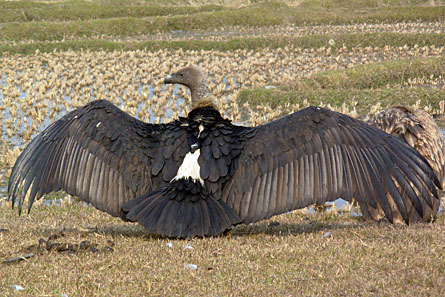Watching out for vultures
Farmers giving medicine to cows are accidentally poisoning vultures, again
 |
|
Oriental white-backed vulture populations in South Asia have proved extremely sensitive to the livestock drug diclofenac and have declined by more than 99 percent.
|
| Richard Cuthbert |
What’s good for one may not be good for one animal may not be good for all. Consider the case of ketoprofen. This drug provides pain relief and reduces swelling. In India, some farmers give ketoprofen to their cattle and other animals for pain relief.
But giving ketoprofen to cattle may ultimately poison vultures, a new study finds. Vultures are giant, flying scavengers. They eat the carcasses of dead animals, including cattle. For farmers, vultures act like nature’s clean-up crews. The birds’ feasts mean that farmers don’t have to figure out how to dispose of the bodies of dead animals. And vultures eat fast: Dozens of birds could take care of a dead animal in 20 minutes.
When a vulture eats a dead animal, however, it may also end up eating any medications that had been in its meal. In the case of ketoprofen, this is a big problem. And least, that’s the conclusion of a study by Richard Cuthbert and his co-workers. Cuthbert is a zoologist, or a scientist who studies animals. He works in England. He recently led a team of scientists from around the world in a study of how ketoprofen affects vultures. Even small amounts of the drug can kill a vulture, they found.
Vultures died after being given ketoprofen directly, or after eating the body of an animal that recently had been given the pain medication. It didn’t take much: Vultures died after consuming less than one-millionth of their body weight in ketoprofen. That amount shows that even veterinarians should be very careful about giving ketoprofen as a medicine to birds, the team concludes.
This isn’t the first time farmers have accidentally poisoned vultures. Another drug that reduces swelling, called diclofenac, became popular among farmers about 20 years ago. It also turned out to be toxic to vultures. As a result, three different species now are on the verge of becoming extinct.
In 2004, Lindsay Oaks, a veterinarian at Washington State University, helped connect the vulture decline to diclofenac. He told Science News that even a small number of tainted carcasses could cause a large decline in vulture populations. Since Oaks’ study, countries such as India, Pakistan and Nepal have outlawed diclofenac for use in animals.
The way a drug given to a cow can end up killing a vulture is one example of how interconnected the food chain is. Scientists such as Cuthbert look at the effect of medicines on vultures to learn what might prevent a similar disaster in the future. Prevention would not only help the vultures. It could also help the farmers. They now have to deal with carcasses that sit rotting. Vultures may be rather repulsive, but they do important work for the planet, Cuthbert notes. And these birds are connected to other species.
“With their heads in a carcass, they may not be that attractive, but they’re doing their job,” Cuthbert told Science News. Plus, he added, “They’re mind-blowing flyers.”
POWER WORDS
food chain A succession of organisms in an ecological community that constitutes a continuation of food energy from one organism to another as each consumes a lower member and in turn is preyed upon by a higher member.
veterinarian A scientist who studies the causes, diagnoses and treatments of diseases and injuries in animals, especially domestic animals.
zoology The branch of biology that deals with animals and animal life, including the study of the structure, physiology, development and classification of animals.
scavenger An animal, such as a bird or insect, that feeds on dead or decaying matter.
carcass The dead body of an animal, such as one slaughtered for food.







